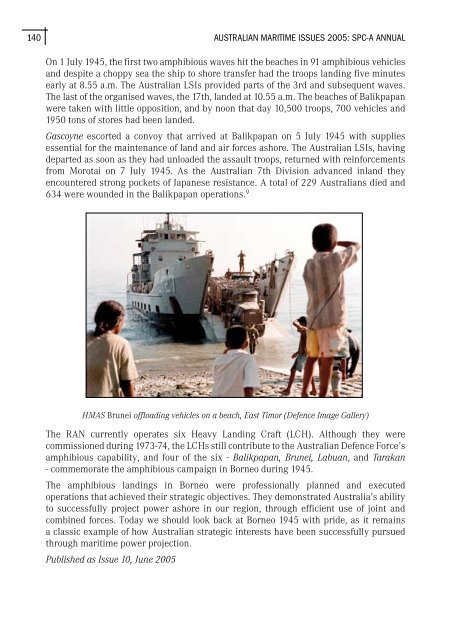Australian Maritime Issues 2005 - Royal Australian Navy
Australian Maritime Issues 2005 - Royal Australian Navy
Australian Maritime Issues 2005 - Royal Australian Navy
Create successful ePaper yourself
Turn your PDF publications into a flip-book with our unique Google optimized e-Paper software.
140<br />
AUSTRALIAN MARITIME ISSUES <strong>2005</strong>: SPC-A ANNUAL<br />
On 1 July 1945, the first two amphibious waves hit the beaches in 91 amphibious vehicles<br />
and despite a choppy sea the ship to shore transfer had the troops landing five minutes<br />
early at 8.55 a.m. The <strong>Australian</strong> LSIs provided parts of the 3rd and subsequent waves.<br />
The last of the organised waves, the 17th, landed at 10.55 a.m. The beaches of Balikpapan<br />
were taken with little opposition, and by noon that day 10,500 troops, 700 vehicles and<br />
1950 tons of stores had been landed.<br />
Gascoyne escorted a convoy that arrived at Balikpapan on 5 July 1945 with supplies<br />
essential for the maintenance of land and air forces ashore. The <strong>Australian</strong> LSIs, having<br />
departed as soon as they had unloaded the assault troops, returned with reinforcements<br />
from Morotai on 7 July 1945. As the <strong>Australian</strong> 7th Division advanced inland they<br />
encountered strong pockets of Japanese resistance. A total of 229 <strong>Australian</strong>s died and<br />
634 were wounded in the Balikpapan operations. 9<br />
HMAS Brunei offloading vehicles on a beach, East Timor (Defence Image Gallery)<br />
The RAN currently operates six Heavy Landing Craft (LCH). Although they were<br />
commissioned during 1973-74, the LCHs still contribute to the <strong>Australian</strong> Defence Force’s<br />
amphibious capability, and four of the six - Balikpapan, Brunei, Labuan, and Tarakan<br />
- commemorate the amphibious campaign in Borneo during 1945.<br />
The amphibious landings in Borneo were professionally planned and executed<br />
operations that achieved their strategic objectives. They demonstrated Australia’s ability<br />
to successfully project power ashore in our region, through efficient use of joint and<br />
combined forces. Today we should look back at Borneo 1945 with pride, as it remains<br />
a classic example of how <strong>Australian</strong> strategic interests have been successfully pursued<br />
through maritime power projection.<br />
Published as Issue 10, June <strong>2005</strong>

















